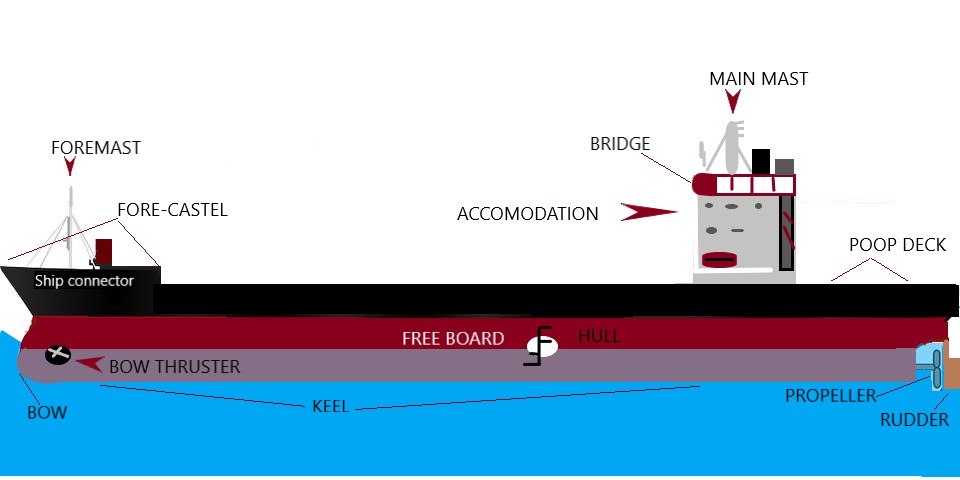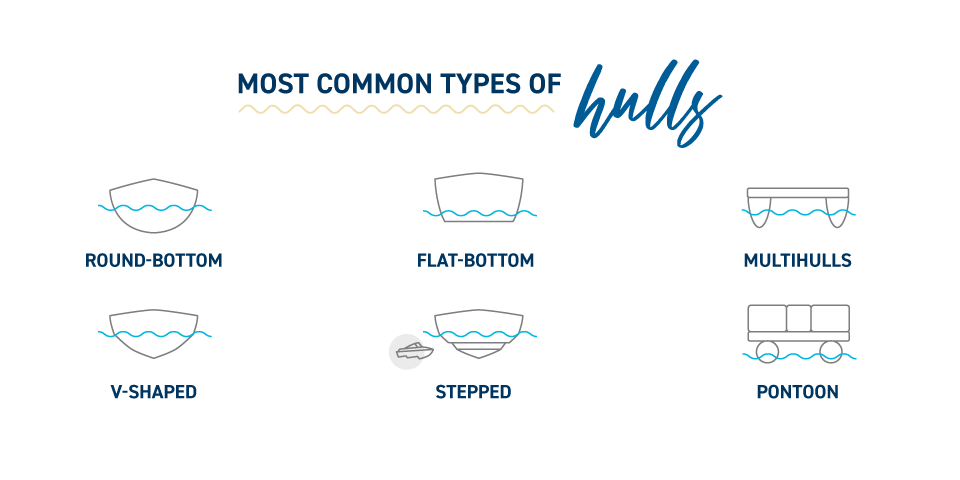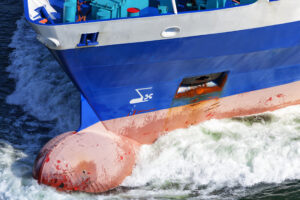The hull is the heart of any vessel, its essential structural component that protects everything within it. From the cargo to the engine, and even the crew, boat hulls act as watertight enclosures that shield against the elements, structural damage, and more. However, the design of a hull is far from simple. The shape and type of hull play a critical role in a ship’s overall performance, stability, and safety, directly impacting its speed, fuel efficiency, and manoeuvrability.
This blog explores the basics of hull types and designs, examining how different hull shapes serve unique purposes in the world of maritime vessels and explaining some of the core concepts involved in designing a ship’s hull.

What is Ship Hull Design?
Hull design focuses on the shape, structure, and strength of the hull to balance a ship’s performance, stability, and safety needs. In the world of naval architecture, every element of a hull is strategically crafted to support the ship’s purpose. For instance, a cargo ship designed for long hauls will have a hull that optimizes stability and fuel efficiency, while a speedboat will have a hull shaped to cut through water quickly.
The hull form, which includes various shapes like chined and semi-round bilge hulls, significantly impacts a vessel’s performance characteristics such as stability and drag.
When designing a hull, engineers consider multiple factors like:
-
Hydrostatics: the ship’s ability to float and remain stable
-
Hydrodynamics: the vessel’s performance in moving through water
-
Structural Integrity: the hull’s ability to withstand various forces
These considerations guide the design of different hull types, each suited to specific kinds of vessels and water conditions.

Common Hull Types and Designs
Let’s dive into some common types of hulls and understand how each impacts the ship’s performance:
Understanding the ship’s hull is crucial as it serves as a watertight enclosure and a protective structure, ensuring the vessel’s stability and structural integrity.

1. Flat-Bottom Hulls
Flat-bottom hulls are exactly as they sound—flat along the bottom. These hulls provide excellent stability, especially in calm, shallow waters, making them popular for small boats used on lakes and rivers. However, they are not ideal for rough waters since the flat shape can result in a bumpy ride.
2. Round-Bottom Hulls
Often used in canoes and other small, slow-moving boats, round-bottom hulls are designed to move smoothly through water, reducing resistance. This type of hull is known for its ability to “displace” water, which means it doesn’t rise above the waterline but rather moves within it. While round-bottom hulls are energy-efficient, they can be less stable and more prone to capsizing in rough conditions.
3. V-Shaped Hulls
V-shaped hulls are commonly found on powerboats. They are designed to slice through water at higher speeds, which makes them suitable for choppy or open waters. A V-shaped hull allows the boat to “plane” on top of the water at high speeds, reducing drag. It also provides a smoother ride through waves, making it ideal for recreational boating and sports.
4. Multi-Hulled Boats
Catamarans and pontoon boats fall under this category. With two or more hulls, these vessels offer greater stability than single-hull boats, which is why multi-hulled designs are popular for passenger ferries and leisure boats. Depending on their specific design, multi-hulls can either displace water or plane on top of it.
In structural analysis, modeling the entire hull is essential to ensure accuracy in calculations and compliance with safety standards.
Hull Structure and Strength
The hull structure and strength of a ship are critical components that ensure the vessel’s stability and safety at sea. The hull structure is designed to withstand various loads, including bending stress, wave loads, and other external forces. The strength of the hull is determined by its material properties, such as steel or fiberglass, and its design configuration.
A three-dimensional structural model of the hull is typically used to analyze its strength and stability. This model takes into account the hull’s shape, size, and material properties, as well as the loads it will encounter during operation. The model is used to simulate various scenarios, such as wave loads and bending stress, to ensure that the hull can withstand these forces.
The hull structure is composed of several key components, including the keel, frames, and plating. The keel is the bottom-most part of the hull, and it provides the foundation for the rest of the structure. The frames are the transverse members that connect the keel to the deck, and they provide additional strength and stability to the hull. The plating is the outer layer of the hull, and it provides a watertight seal to protect the vessel’s cargo and passengers.
In addition to its structural components, the hull’s strength is also influenced by its design configuration. For example, a ship with a narrow beam and a deep draft will be more stable than a ship with a wide beam and a shallow draft. Similarly, a ship with a rounded hull shape will be more resistant to wave loads than a ship with a flat hull shape.
How Hull Design Impacts Ship Performance
Hull design significantly impacts how a ship moves, how stable it is, and how much fuel it consumes. Here are some core ship hull design capabilities that naval architects consider when crafting a vessel’s hull:
1. Stability and Manoeuvrability
The hull’s shape directly affects a vessel’s stability. A flatter or broader hull will be more stable, but it might compromise speed. On the other hand, narrow or V-shaped hulls offer better manoeuvrability and higher speeds but may be less stable, especially at low speeds.
2. Energy Efficiency
Hull design affects fuel consumption, as certain hull shapes require less power to maintain speed. Displacement hulls, which glide through the water with minimal resistance, are generally more fuel-efficient than planing hulls, which require more power to rise above the water.
3. Load-Bearing Capacity
The type of hull also determines how much weight a vessel can safely carry. Cargo ships, tankers, and bulk carriers often have fuller, rounded hulls to maximize load-bearing capacity, while racing yachts and speedboats have narrower hulls optimized for speed over carrying capacity.
4. Resistance and Drag
A well-designed hull minimizes resistance from water, allowing the ship to move more efficiently. Hull designs are tested for drag through tank tests and hydrostatic calculations, with modifications made to achieve the desired performance. This is especially important in vessels like submarines and racing yachts, where minimizing drag is crucial. Having multiple building docks in shipyards allows for better planning and selection of space based on the ship’s dimensions, particularly in regard to docking and undocking processes.
Sustainability in Hull Design
Sustainability is increasingly central to hull design, with shipbuilders aiming to reduce environmental impact while enhancing performance. Designing hulls to be energy-efficient and eco-friendly can help the maritime industry meet its sustainability goals. Here are some ways hull design supports greener practices:
1. Optimized Hull Shapes for Fuel Efficiency
Reducing water resistance through streamlined hull designs allows ships to require less power to move, thereby consuming less fuel. For instance, vessels equipped with bulbous bows can cut through water more effectively, significantly decreasing drag and fuel consumption. This is a win-win for both operational costs and environmental impact.
2. Eco-Friendly Hull Coatings
Special hull coatings prevent biofouling (the buildup of marine organisms like algae) and reduce drag without harming marine ecosystems. These coatings not only help ships cut fuel costs by maintaining a smoother hull surface but also limit the use of toxic chemicals, reducing pollution.
3. Lightweight Materials
Designers are increasingly experimenting with lightweight, durable materials that reduce a ship’s overall weight without compromising strength. By using such materials, ships can achieve better fuel efficiency, meaning fewer emissions.
4. Electric Propulsion Compatibility
Hulls are now being designed to work seamlessly with electric propulsion systems and alternative energy sources like hydrogen. A well-optimized hull reduces the energy demands of these green systems, making sustainable propulsion a more feasible option.
Hull Nomenclature: Key Terms

Understanding hull design also means knowing the basic terms:
– Bow and Stern: The bow is the front of the hull, while the stern is the rear.
– Sheer: The upward curve of the deck line, helping to keep water off the ship.
– Forward and Aft Perpendiculars: Imaginary lines at the front and back of the ship, used as references for length measurements.
– Length of Waterline: The ship’s length at its designed waterline, crucial for calculating hydrostatics.
Hull Stability and Superstructure Interaction
A hull’s stability involves more than just shape; it also depends on the interaction with the superstructure—the parts of the ship that sit above the main deck. The superstructure can help reduce stress on the hull, providing additional stability. However, if not designed well, it can also add unnecessary weight and increase drag, which can reduce fuel efficiency.
Hull Design Considerations
Hull design is a complex process that involves balancing multiple competing factors, including structural integrity, hydrostatics, hydrodynamics, and special considerations for the ship’s role. The design of the hull must take into account the vessel’s intended use, its operating environment, and the loads it will encounter during operation.
One of the key considerations in hull design is straight-line stability, which refers to the vessel’s ability to maintain its course and resist deviations from its intended path. This is achieved through the use of a combination of design features, including a narrow beam, a deep draft, and a rounded hull shape.
Another important consideration in hull design is directional stability, which refers to the vessel’s ability to maintain its heading and resist changes in direction. This is achieved through the use of design features such as a skeg or a centerboard, which provide additional stability and control.
Hull-superstructure interaction is also an important consideration in hull design. The superstructure, which includes the deckhouse and other above-deck components, can affect the hull’s stability and strength. The design of the superstructure must take into account the hull’s shape and size, as well as the loads it will encounter during operation.
In addition to these considerations, hull design must also take into account the vessel’s operating environment and the loads it will encounter during operation. For example, a ship that will operate in rough seas must be designed to withstand wave loads and other external forces. Similarly, a ship that will carry heavy cargo must be designed to withstand the stresses and strains associated with that cargo.
Conclusion
A ship’s hull is more than just its outer shell—it’s a carefully engineered structure that shapes the ship’s stability, speed, and efficiency. Whether it’s a sleek racing yacht designed for speed, a robust cargo ship built for capacity, or a leisure boat optimized for stability, each hull type serves a unique purpose in maritime travel. With sustainability now a central concern, advancements in hull design continue to drive greener practices. As the maritime industry adopts eco-friendly materials, fuel-saving shapes, and coatings that reduce environmental impact, hull design is at the forefront of building a more sustainable future at sea.
FAQs about Ship Hulls
1. What is the primary purpose of a ship’s hull?
The hull is the watertight enclosure of a ship, designed to protect the cargo, machinery, and accommodations from weather and other environmental elements while ensuring the vessel remains stable and functional.
2. How does hull design affect fuel efficiency?
Hull design plays a big role in fuel efficiency. Displacement hulls tend to be more fuel-efficient at lower speeds, as they move through the water with less resistance. Planning hulls, while requiring more power, can achieve high speeds efficiently on top of the water.
3. What are the main types of hull designs?
The main types of hulls include flat-bottom, round-bottom, V-shaped, and multi-hulled designs. Each type has unique advantages and is suited for specific water conditions and vessel purposes.
4. How are hulls tested during the design phase?
Hulls undergo tank testing, where scale models are tested in water to evaluate resistance, stability, and other performance factors. Additionally, 3D modeling and finite element analysis (FEA) are used to predict how the hull will behave under real-world conditions.
5. What is “sheer”?
Sheer refers to the upward curve of a ship’s deck line from the midsection to the bow and stern. It’s designed to help keep water off the deck, enhancing safety and reducing water resistance.

Leave a Reply